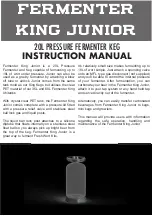
Manual 0-5617 5-19
MIG (GMAW) WELDING
EasyWeld / HandyWeld 160
Setting of the Power Source
Power source and Wirefeeder setting requires some practice by the operator, (however with the Quick Set
feature of the EasyWeld/HandyWeld 160, setting up the correct parameters is a very simple procedure -refer
to section 5.10), as the welding plant has two control settings that have to balance. These are the Wire Feed
Speed control (refer to section 4.02.5) and the welding Voltage Control (refer to section 4.02.5). The welding
current is determined by the Wire Feed Speed control, the current will increase with increased Wire Feed Speed,
resulting in a shorter arc. Less Wire Feed Speed will reduce the current and lengthen the arc. Increasing the
welding voltage hardly alters the current level, but lengthens the arc. By decreasing the voltage, a shorter arc
is obtained with a little change in current level.
When changing to a different electrode wire diameter, different control settings are required. A thinner electrode
wire needs more Wire Feed Speed to achieve the same current level.
A satisfactory weld cannot be obtained if the Wire Feed Speed and Voltage settings are not adjusted to suit
the electrode wire diameter and the thickness of the work piece.
If the Wire Feed Speed is too high for the welding voltage, “stubbing” will occur as the wire dips into the molten
pool and does not melt. Welding in these conditions normally produces a poor weld due to lack of fusion. If,
however, the welding voltage is too high, large drops will form on the end of the wire, causing spatter. The
correct setting of voltage and Wire Feed Speed can be seen in the shape of the weld deposit and heard by a
smooth regular arc sound. Refer to the Weld Guide located on the inside of the wirefeed compartment door
for setup information.
Electrode Wire Size Selection
The choice of Electrode wire size and shielding gas used depends on the following
• Thickness of the metal to be welded
• Type of joint
• Capacity of the wire feed unit and Power Source
• The amount of penetration required
• The deposition rate required
• The bead profile desired
• The position of welding
• Cost of the wire
Summary of Contents for Cigweld EasyWeld 160
Page 8: ...This Page Intentionally Blank ...
Page 14: ...EasyWeld HandyWeld 160 GENERAL INFORMATION 1 6 0 5617 This Page Intentionally Blank ...
Page 26: ...EasyWeld HandyWeld 160 INSTALLATION 3 4 0 5617 This Page Intentionally Blank ...
Page 32: ...EasyWeld HandyWeld 160 OPERATION 4 6 0 5617 This Page Intentionally Blank ...
Page 56: ...MIG GMAW WELDING 5 24 Manual 0 5617 EasyWeld HandyWeld 160 This Page Intentionally Blank ...
Page 70: ...EasyWeld HandyWeld 160 STICK MMAW Welding 6 14 0 5617 This Page Intentionally Blank ...
Page 78: ...KEY SPARE PARTS 8 4 0 5617 EasyWeld HandyWeld 160 This Page Intentionally Blank ...
Page 80: ...EasyWeld HandyWeld 160 APPENDIX A 2 0 5617 This Page Intentionally Blank ...
Page 83: ...EasyWeld HandyWeld 160 This Page Intentionally Blank ...
















































